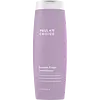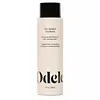What's inside
What's inside
 Key Ingredients
Key Ingredients

No key ingredients
 Benefits
Benefits

 Concerns
Concerns

No concerns
 Ingredients Side-by-side
Ingredients Side-by-side

Water
Skin ConditioningCetyl Alcohol
EmollientCyclopentasiloxane
EmollientBehentrimonium Chloride
PreservativeStearyl Alcohol
EmollientPhenyl Trimethicone
Skin ConditioningButylene Glycol
HumectantPanthenol
Skin ConditioningHydrolyzed Wheat Protein
Skin ConditioningGlycol Stearate
EmollientPolyquaternium-10
Citric Acid
BufferingDisodium EDTA
Phenoxyethanol
PreservativeChlorphenesin
AntimicrobialSorbic Acid
PreservativeWater
Skin ConditioningCetearyl Alcohol
EmollientStearyl Alcohol
EmollientGlycerin
HumectantAmodimethicone
Behentrimonium Chloride
PreservativeAvena Sativa Kernel Extract
AbrasiveAmaranthus Caudatus Seed Extract
Skin ConditioningHydrolyzed Rice Protein
Skin ConditioningHydroxyethylcellulose
Emulsion StabilisingTetrasodium Glutamate Diacetate
Diheptyl Succinate
EmollientCapryloyl Glycerin/Sebacic Acid Copolymer
Skin ConditioningCetrimonium Chloride
AntimicrobialLinoleamidopropyl Pg-Dimonium Chloride Phosphate Dimethicone
Isopropyl Alcohol
SolventTrideceth-3
EmulsifyingTrideceth-15
EmulsifyingAcetic Acid
BufferingEthylhexylglycerin
Skin ConditioningPhenoxyethanol
PreservativeSodium Hydroxide
BufferingCitric Acid
BufferingWater, Cetearyl Alcohol, Stearyl Alcohol, Glycerin, Amodimethicone, Behentrimonium Chloride, Avena Sativa Kernel Extract, Amaranthus Caudatus Seed Extract, Hydrolyzed Rice Protein, Hydroxyethylcellulose, Tetrasodium Glutamate Diacetate, Diheptyl Succinate, Capryloyl Glycerin/Sebacic Acid Copolymer, Cetrimonium Chloride, Linoleamidopropyl Pg-Dimonium Chloride Phosphate Dimethicone, Isopropyl Alcohol, Trideceth-3, Trideceth-15, Acetic Acid, Ethylhexylglycerin, Phenoxyethanol, Sodium Hydroxide, Citric Acid
 Reviews
Reviews

Ingredients Explained
These ingredients are found in both products.
Ingredients higher up in an ingredient list are typically present in a larger amount.
This ingredient is a preservative and often used for it's anti-static properties. You'll most likely see this ingredient in hair conditioners.
It does not cause irritation or sensitization in leave-on products at 1-5%.
Citric Acid is an alpha hydroxy acid (AHA) naturally found in citrus fruits like oranges, lemons, and limes.
Like other AHAs, citric acid can exfoliate skin by breaking down the bonds that hold dead skin cells together. This helps reveal smoother and brighter skin underneath.
However, this exfoliating effect only happens at high concentrations (20%) which can be hard to find in cosmetic products.
Due to this, citric acid is usually included in small amounts as a pH adjuster. This helps keep products slightly more acidic and compatible with skin's natural pH.
In skincare formulas, citric acid can:
While it can provide some skin benefits, research shows lactic acid and glycolic acid are generally more effective and less irritating exfoliants.
Most citric acid used in skincare today is made by fermenting sugars (usually from molasses). This synthetic version is identical to the natural citrus form but easier to stabilize and use in formulations.
Read more about some other popular AHA's here:
Learn more about Citric AcidPhenoxyethanol is a preservative that has germicide, antimicrobial, and aromatic properties. Studies show that phenoxyethanol can prevent microbial growth. By itself, it has a scent that is similar to that of a rose.
It's often used in formulations along with Caprylyl Glycol to preserve the shelf life of products.
Stearyl Alcohol is a type of fatty alcohol from stearic acid. It is a white, waxy compound used to emulsify ingredients.
Fatty Alcohols are most often used as an emollient or to thicken a product. Emollients help soothe and hydrate the skin by trapping moisture.
They are usually derived from natural fats and oils and therefore do not have the same drying or irritating effect as solvent alcohols. FDA allows products labeled "alcohol-free" to have fatty alcohols.
Learn more about Stearyl AlcoholWater. It's the most common cosmetic ingredient of all. You'll usually see it at the top of ingredient lists, meaning that it makes up the largest part of the product.
So why is it so popular? Water most often acts as a solvent - this means that it helps dissolve other ingredients into the formulation.
You'll also recognize water as that liquid we all need to stay alive. If you see this, drink a glass of water. Stay hydrated!
Learn more about Water